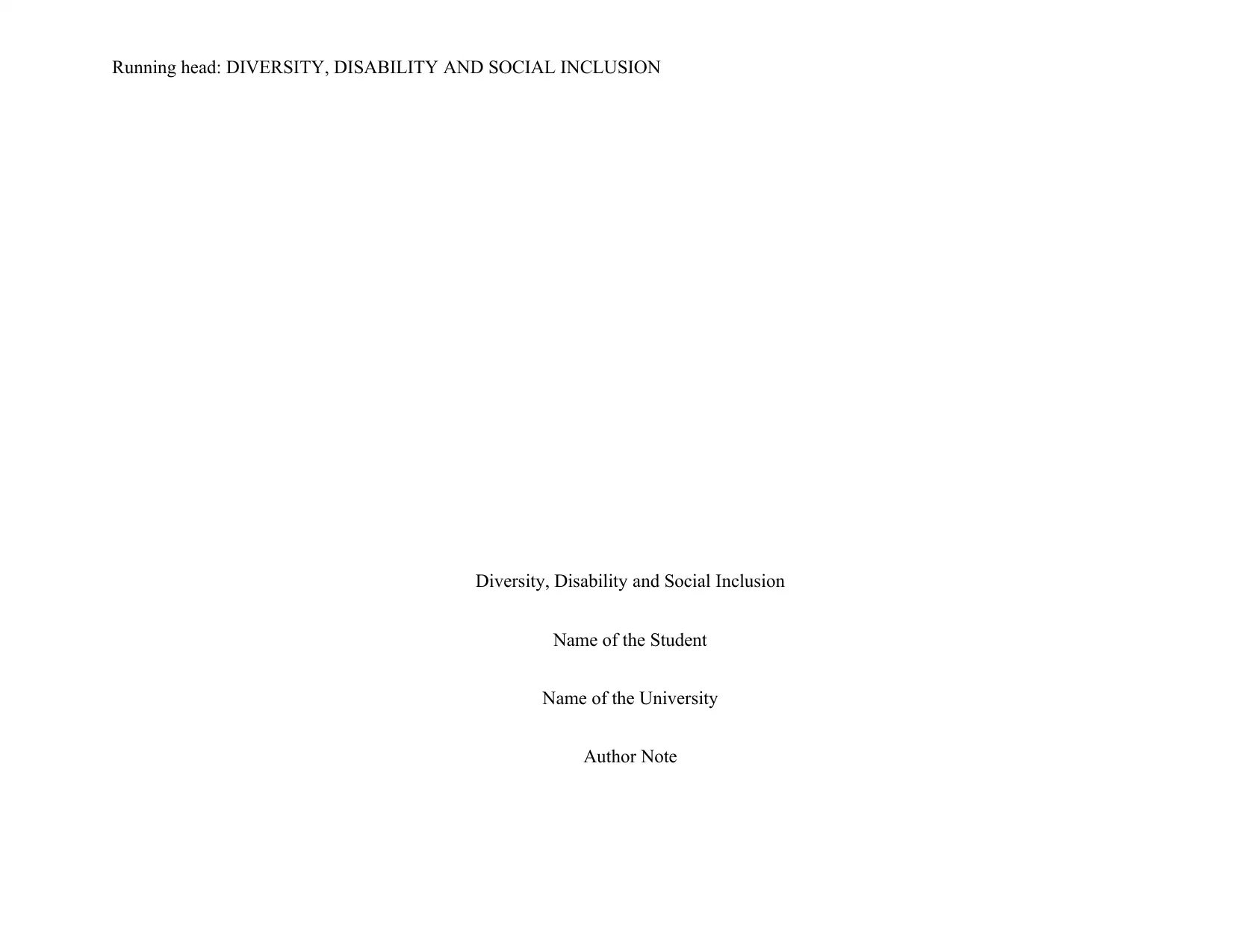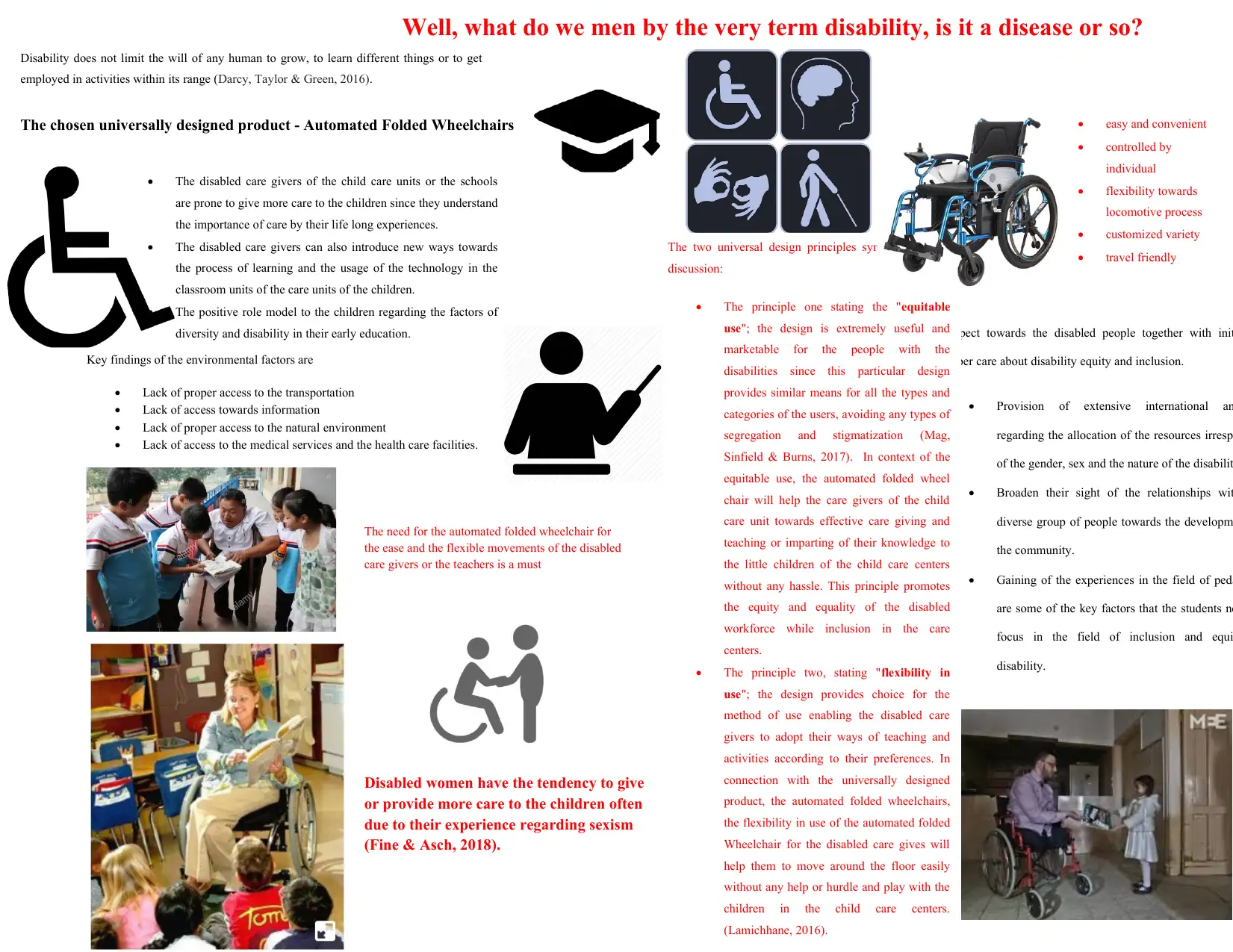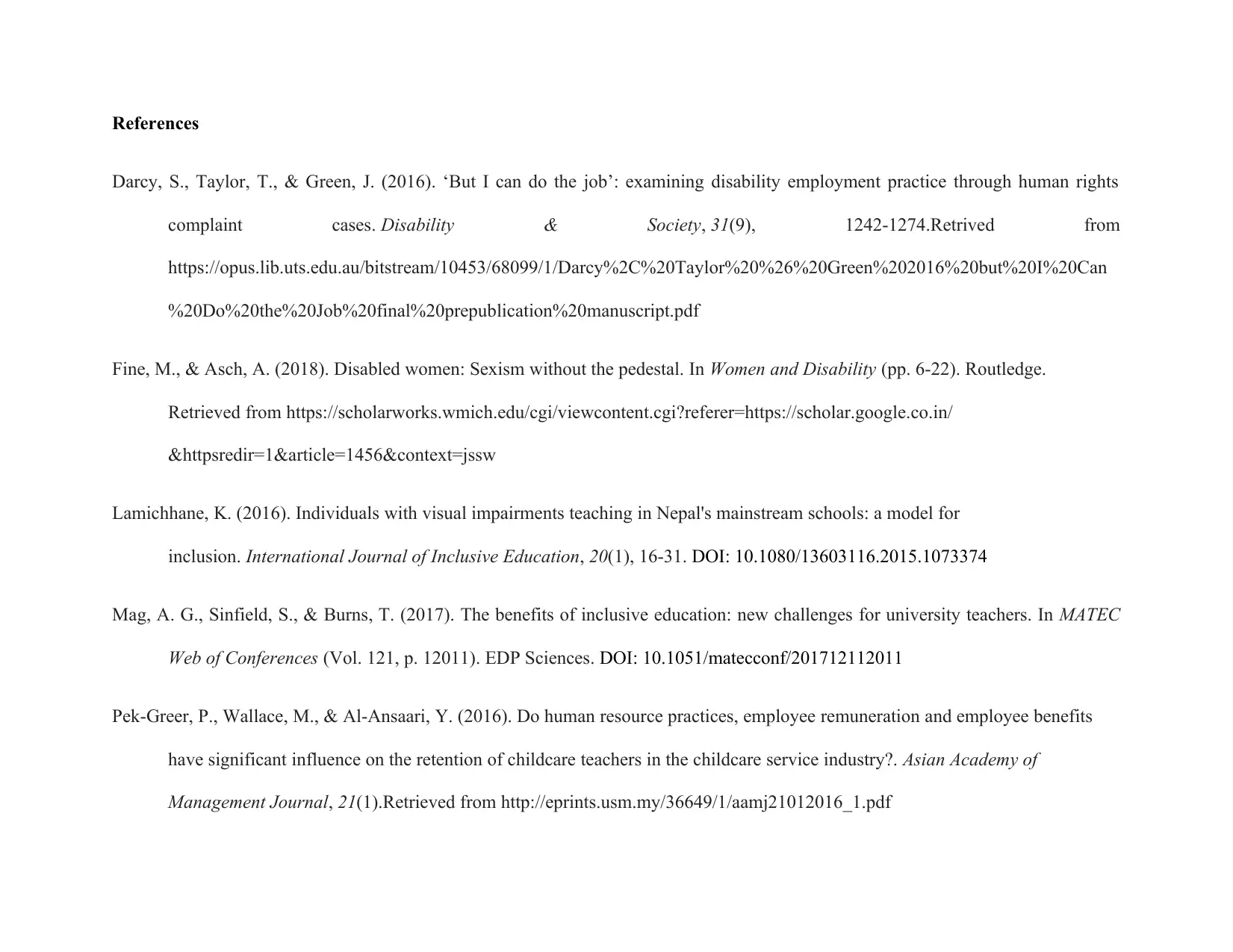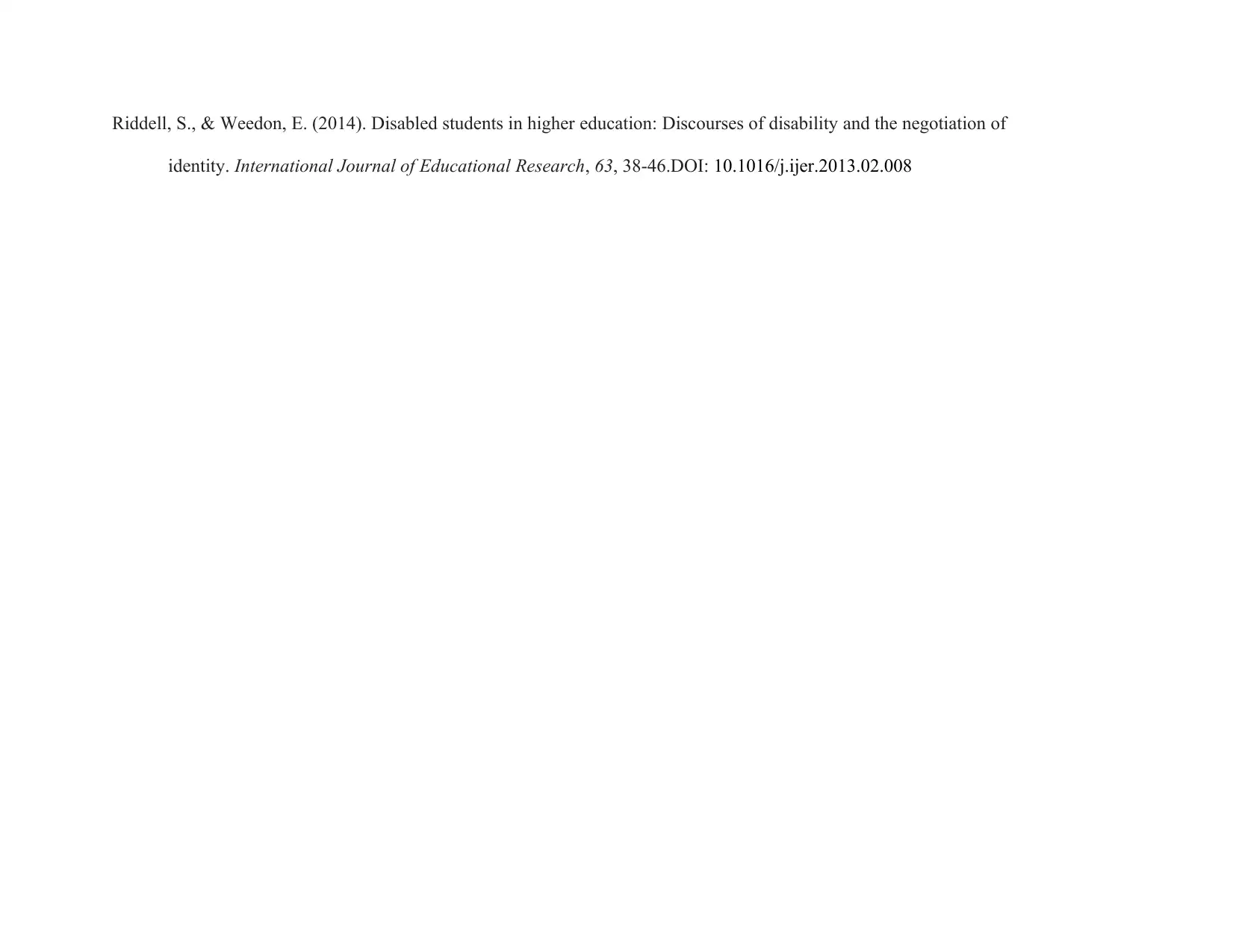HDS106, Deakin Uni: Diversity, Disability and Social Inclusion Report
VerifiedAdded on 2023/06/03
|6
|926
|264
Report
AI Summary
This report delves into the multifaceted concepts of diversity, disability, and social inclusion, emphasizing the application of universal design principles. The report analyzes an automated folded wheelchair as a universally designed product, highlighting its ease of use, flexibility, and benefits for disabled caregivers and children in educational settings. It discusses the importance of equitable access, flexibility, and the positive impact of role models in fostering inclusion. The report also identifies environmental factors that hinder inclusion, such as lack of access to transportation, information, and healthcare. Drawing on research and examples, the report stresses the significance of inclusive practices in education and community relationships. It also includes an annotated bibliography with relevant references supporting the concepts presented.

Running head: DIVERSITY, DISABILITY AND SOCIAL INCLUSION
Diversity, Disability and Social Inclusion
Name of the Student
Name of the University
Author Note
Diversity, Disability and Social Inclusion
Name of the Student
Name of the University
Author Note
Paraphrase This Document
Need a fresh take? Get an instant paraphrase of this document with our AI Paraphraser

Part A:

The disabled care givers of the child care units or the schools
are prone to give more care to the children since they understand
the importance of care by their life long experiences.
The disabled care givers can also introduce new ways towards
the process of learning and the usage of the technology in the
classroom units of the care units of the children.
The positive role model to the children regarding the factors of
diversity and disability in their early education.
Disability does not limit the will of any human to grow, to learn different things or to get
employed in activities within its range (Darcy, Taylor & Green, 2016).
Well, what do we men by the very term disability, is it a disease or so?
Key findings of the environmental factors are
Lack of proper access to the transportation
Lack of access towards information
Lack of proper access to the natural environment
Lack of access to the medical services and the health care facilities.
Respect towards the disabled people together with init
proper care about disability equity and inclusion.
Provision of extensive international an
regarding the allocation of the resources irresp
of the gender, sex and the nature of the disabilit
Broaden their sight of the relationships wit
diverse group of people towards the developm
the community.
Gaining of the experiences in the field of ped
are some of the key factors that the students ne
focus in the field of inclusion and equi
disability.
The two universal design principles syncing with the
discussion:
The principle one stating the "equitable
use"; the design is extremely useful and
marketable for the people with the
disabilities since this particular design
provides similar means for all the types and
categories of the users, avoiding any types of
segregation and stigmatization (Mag,
Sinfield & Burns, 2017). In context of the
equitable use, the automated folded wheel
chair will help the care givers of the child
care unit towards effective care giving and
teaching or imparting of their knowledge to
the little children of the child care centers
without any hassle. This principle promotes
the equity and equality of the disabled
workforce while inclusion in the care
centers.
The principle two, stating "flexibility in
use"; the design provides choice for the
method of use enabling the disabled care
givers to adopt their ways of teaching and
activities according to their preferences. In
connection with the universally designed
product, the automated folded wheelchairs,
the flexibility in use of the automated folded
Wheelchair for the disabled care gives will
help them to move around the floor easily
without any help or hurdle and play with the
children in the child care centers.
(Lamichhane, 2016).
Disabled women have the tendency to give
or provide more care to the children often
due to their experience regarding sexism
(Fine & Asch, 2018).
The chosen universally designed product - Automated Folded Wheelchairs
The need for the automated folded wheelchair for
the ease and the flexible movements of the disabled
care givers or the teachers is a must
easy and convenient
controlled by
individual
flexibility towards
locomotive process
customized variety
travel friendly
are prone to give more care to the children since they understand
the importance of care by their life long experiences.
The disabled care givers can also introduce new ways towards
the process of learning and the usage of the technology in the
classroom units of the care units of the children.
The positive role model to the children regarding the factors of
diversity and disability in their early education.
Disability does not limit the will of any human to grow, to learn different things or to get
employed in activities within its range (Darcy, Taylor & Green, 2016).
Well, what do we men by the very term disability, is it a disease or so?
Key findings of the environmental factors are
Lack of proper access to the transportation
Lack of access towards information
Lack of proper access to the natural environment
Lack of access to the medical services and the health care facilities.
Respect towards the disabled people together with init
proper care about disability equity and inclusion.
Provision of extensive international an
regarding the allocation of the resources irresp
of the gender, sex and the nature of the disabilit
Broaden their sight of the relationships wit
diverse group of people towards the developm
the community.
Gaining of the experiences in the field of ped
are some of the key factors that the students ne
focus in the field of inclusion and equi
disability.
The two universal design principles syncing with the
discussion:
The principle one stating the "equitable
use"; the design is extremely useful and
marketable for the people with the
disabilities since this particular design
provides similar means for all the types and
categories of the users, avoiding any types of
segregation and stigmatization (Mag,
Sinfield & Burns, 2017). In context of the
equitable use, the automated folded wheel
chair will help the care givers of the child
care unit towards effective care giving and
teaching or imparting of their knowledge to
the little children of the child care centers
without any hassle. This principle promotes
the equity and equality of the disabled
workforce while inclusion in the care
centers.
The principle two, stating "flexibility in
use"; the design provides choice for the
method of use enabling the disabled care
givers to adopt their ways of teaching and
activities according to their preferences. In
connection with the universally designed
product, the automated folded wheelchairs,
the flexibility in use of the automated folded
Wheelchair for the disabled care gives will
help them to move around the floor easily
without any help or hurdle and play with the
children in the child care centers.
(Lamichhane, 2016).
Disabled women have the tendency to give
or provide more care to the children often
due to their experience regarding sexism
(Fine & Asch, 2018).
The chosen universally designed product - Automated Folded Wheelchairs
The need for the automated folded wheelchair for
the ease and the flexible movements of the disabled
care givers or the teachers is a must
easy and convenient
controlled by
individual
flexibility towards
locomotive process
customized variety
travel friendly
⊘ This is a preview!⊘
Do you want full access?
Subscribe today to unlock all pages.

Trusted by 1+ million students worldwide

Paraphrase This Document
Need a fresh take? Get an instant paraphrase of this document with our AI Paraphraser

References
Darcy, S., Taylor, T., & Green, J. (2016). ‘But I can do the job’: examining disability employment practice through human rights
complaint cases. Disability & Society, 31(9), 1242-1274.Retrived from
https://opus.lib.uts.edu.au/bitstream/10453/68099/1/Darcy%2C%20Taylor%20%26%20Green%202016%20but%20I%20Can
%20Do%20the%20Job%20final%20prepublication%20manuscript.pdf
Fine, M., & Asch, A. (2018). Disabled women: Sexism without the pedestal. In Women and Disability (pp. 6-22). Routledge.
Retrieved from https://scholarworks.wmich.edu/cgi/viewcontent.cgi?referer=https://scholar.google.co.in/
&httpsredir=1&article=1456&context=jssw
Lamichhane, K. (2016). Individuals with visual impairments teaching in Nepal's mainstream schools: a model for
inclusion. International Journal of Inclusive Education, 20(1), 16-31. DOI: 10.1080/13603116.2015.1073374
Mag, A. G., Sinfield, S., & Burns, T. (2017). The benefits of inclusive education: new challenges for university teachers. In MATEC
Web of Conferences (Vol. 121, p. 12011). EDP Sciences. DOI: 10.1051/matecconf/201712112011
Pek-Greer, P., Wallace, M., & Al-Ansaari, Y. (2016). Do human resource practices, employee remuneration and employee benefits
have significant influence on the retention of childcare teachers in the childcare service industry?. Asian Academy of
Management Journal, 21(1).Retrieved from http://eprints.usm.my/36649/1/aamj21012016_1.pdf
Darcy, S., Taylor, T., & Green, J. (2016). ‘But I can do the job’: examining disability employment practice through human rights
complaint cases. Disability & Society, 31(9), 1242-1274.Retrived from
https://opus.lib.uts.edu.au/bitstream/10453/68099/1/Darcy%2C%20Taylor%20%26%20Green%202016%20but%20I%20Can
%20Do%20the%20Job%20final%20prepublication%20manuscript.pdf
Fine, M., & Asch, A. (2018). Disabled women: Sexism without the pedestal. In Women and Disability (pp. 6-22). Routledge.
Retrieved from https://scholarworks.wmich.edu/cgi/viewcontent.cgi?referer=https://scholar.google.co.in/
&httpsredir=1&article=1456&context=jssw
Lamichhane, K. (2016). Individuals with visual impairments teaching in Nepal's mainstream schools: a model for
inclusion. International Journal of Inclusive Education, 20(1), 16-31. DOI: 10.1080/13603116.2015.1073374
Mag, A. G., Sinfield, S., & Burns, T. (2017). The benefits of inclusive education: new challenges for university teachers. In MATEC
Web of Conferences (Vol. 121, p. 12011). EDP Sciences. DOI: 10.1051/matecconf/201712112011
Pek-Greer, P., Wallace, M., & Al-Ansaari, Y. (2016). Do human resource practices, employee remuneration and employee benefits
have significant influence on the retention of childcare teachers in the childcare service industry?. Asian Academy of
Management Journal, 21(1).Retrieved from http://eprints.usm.my/36649/1/aamj21012016_1.pdf

Riddell, S., & Weedon, E. (2014). Disabled students in higher education: Discourses of disability and the negotiation of
identity. International Journal of Educational Research, 63, 38-46.DOI: 10.1016/j.ijer.2013.02.008
identity. International Journal of Educational Research, 63, 38-46.DOI: 10.1016/j.ijer.2013.02.008
⊘ This is a preview!⊘
Do you want full access?
Subscribe today to unlock all pages.

Trusted by 1+ million students worldwide
1 out of 6
Related Documents
Your All-in-One AI-Powered Toolkit for Academic Success.
+13062052269
info@desklib.com
Available 24*7 on WhatsApp / Email
![[object Object]](/_next/static/media/star-bottom.7253800d.svg)
Unlock your academic potential
Copyright © 2020–2025 A2Z Services. All Rights Reserved. Developed and managed by ZUCOL.




